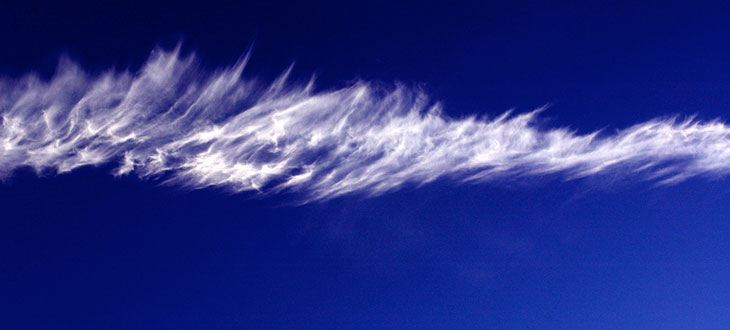
Image: Jeff Kubina via flickr, CC BY
BY Jyoti Madhusoodanan, Inside Science
(Inside Science) -- Showers fall to Earth’s surface as rain, snow, sleet or hail. But high in the clouds, water molecules often begin to come together as tiny ice crystals that form around miniscule particles of dust. The microscopic crystals are big players in creating rain and lightning, and also heat and cool the planet by bouncing sunlight off clouds.
The airborne dust particles that seed ice crystals – a mix of minerals, soil, microbes, and pollutants – are swirled into the atmosphere from both land and sea. But researchers have noticed that only one in several thousand tiny, floating dust particles act as a nucleus, or core, for forming ice crystals. This suggests, according to scientists, that the few particles that do seed, or nucleate, ice crystals have unusual physical or chemical properties. The idea has propelled a decades-long quest to identify these rare traits.
Daniel Knopf, a chemist at Stony Brook University in New York, and his colleagues set out to examine the nuclei of naturally occurring ice crystals. The researchers collected samples – gulps of aerosols gathered from clouds – over central California. From that sample, they analyzed the physical and chemical properties of approximately 25,000 dust particles, including some found inside ice crystals.
They fired light and electrons at the dust to learn about their physical surfaces, studied the X-rays they absorbed and took other measures to analyze the dust’s chemical makeup. Yet – despite the rarity of ice nuclei – the researchers failed to find obvious traits that set ice-forming dust apart from those that did not seed ice crystals.
Instead, a majority of ice-nucleating dust particles were composed of a mix of sea salt and organic materials, some of the most common chemicals found in the air above central California. The results, presented at the annual fall meeting of the American Geophysical Union in December, suggest that ice crystals form through a random physical process rather than as a result of any specific chemicals that make some dust grains more effective ice nucleators, according to Knopf.
The new work is more quantitative than similar analyses performed in the past, according to Knopf.
Rather than continuing on a quest to find special particles that can initiate ice crystallization, scientists may be able to focus on unique physical conditions that cause crystals to form.
“It’s fascinating that they used very high resolution techniques and didn’t find anything special about any ice-nucleating particles,” said atmospheric scientist Sarah Brooks of Texas A&M University in College Station, who was not involved with the study. “Either there’s nothing special about the individual particles which ice grows upon, or it’s still possible that an even [more advanced] technique would show us differences.”
But both Brooks and Knopf concur that it is too early to conclude that these results apply to all particles that seed ice crystals in clouds.
Across the world, aerosols in the atmosphere are a product of their surroundings – ocean air carries more sea salt, clouds above rainforests bear more organic matter, and desert air is often heavy with mineral dust. Not all materials may behave in similar ways to crystallize ice. The surface area of dust in clouds – determined by the sheer number and size of particles – also plays an important role.
“If there is a particle with different chemistry that has a different probability of nucleating ice, the chemistry and physical properties of the surface still play a role,” said Knopf.
Ice crystals also form through many different physical processes, Brooks explained. For example, water can condense around dust before it freezes in some instances; in others, ice may be deposited around the solid surface, while other crystals may be formed when dust is immersed in super-cooled droplets of water, or simply frozen. The different paths to forming an ice crystal depend on temperature, the amount of water vapor, and many other physical factors. When cloud-borne ice crystals grow in size and number and encounter the right weather patterns, they may fall to the surface and become more familiar forms such as rain and snow.
Since the present results are derived from a single region in central California, and only consider a few ways ice crystals might form, it’s too early to assume unusual ice-nucleating particles are absent everywhere, cautioned Brooks. “It may be applicable to some other regions over land, such as in urban areas,” she said. “But before we go very far, it’s important to look at more types of particles."
Viewing ice nucleation as a random physical event – rather than hunting a rare, special kind of particle in the atmosphere – may help improve scientists' understanding of the Earth's atmosphere and simplify global climate models, Knopf suggested.
“If ice nucleation only ever occurred on one in a million particles, the probability of ice nucleation would be very small,” he explained. “But it rains somewhere on the planet every day, and precipitation is often triggered by ice formation in clouds.”
Jyoti Madhusoodanan is a science writer based in San Jose, California. She tweets at @smjyoti. Reprinted with permission from Inside Science, an editorially independent news product of the American Institute of Physics, a nonprofit organization dedicated to advancing, promoting and serving the physical sciences.




Comments